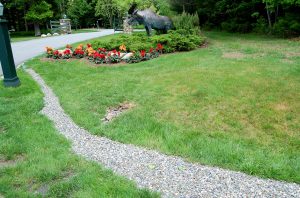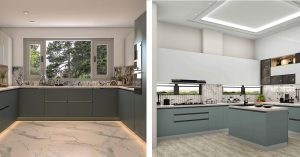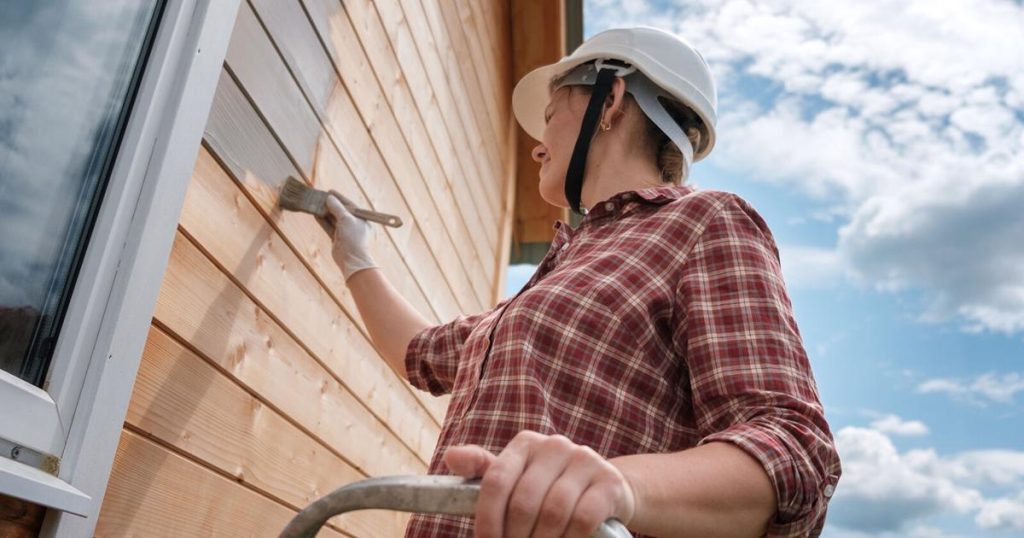our home is a valuable asset, and making improvements to it can boost its value even more (not to mention make it nicer to live in).
Of course, redos and remodels don’t come cheap — especially in these inflationary times — making it difficult to schedule them. In fact, Bankrate’s recent “Delayed Financial Milestones” survey found that 25% of Americans have delayed home improvements and renovations due to the current state of the economy.
All the more reason, then, to focus on getting the most bang for your redo buck: projects that offer a good return on investment and/or add substantial, demonstrated worth to your home.
Whether your renovation aim is to sell your home soon or make it more habitable for yourself, here are eight high-value renovations to prioritize.
To help boost the value of your home, begin by decreasing the amount of stuff that’s inside it. Cleaning and decluttering are relatively inexpensive tasks, even in bigger homes. Professionally cleaning a four-bedroom home averages between $200 and $225, according to HomeAdvisor.
Of course, you could save money by doing the work yourself. Start by going through cabinets and closets and making donation piles. Then clean out drawers and other storage areas, making sure you’re not keeping anything you don’t need or want.
2. Add usable square footage
Adding more usable space to an existing home can make a lot of financial sense, especially in areas where acreage is limited — and almost always enhances a home’s worth.
Homes are valued and priced by the livable square feet they contain, and the more livable square feet, the better, says Benjamin Ross, a Realtor and real estate investor based in Corpus Christi, Texas. As a result, adding a bathroom, a great room or another needed space to a home can increase function and add value.
Adding a separate in-law suite (officially known as an accessory dwelling unit) can also be a smart idea. “Most homes do not have this feature,” says Ross, “ so adding one sets you apart from the competition when it is time to sell.”
3. Make your home more energy-efficient
Projects that lower utility bills are a smart way to increase the value of your home. Installing a smart thermostat, for example, helps improve efficiency and save money, says Scott Ewald, director, brand & content marketing at Trane, the HVAC company.
“The right smart thermostat will allow a homeowner to control their home’s climate from anywhere, giving them the power to manage energy costs regardless of whether they are sitting on the couch or away on vacation,” says Ewald. “Such investments in home tech — particularly when connected to the HVAC, which is the largest mechanical system in the home — provides a strong selling point and highlights the home’s overall comfort, functionality, energy efficiency and convenience.”
It can cost between $200 to $500 to make this quick upgrade, according to HomeAdvisor, or an average of about $350.
Other ways to improve your home’s efficiency and value include replacing old, leaky windows, installing energy-efficient home appliances and adding insulation to your home. Some of these will be pricier projects, of course.
4. Spruce it up with fresh paint
A fresh coat of paint can make even dated exteriors and interiors look fresh and new — and it’s not that expensive, either.
Begin by repainting any rooms with an “odd” color scheme, says Timothy Wiedman, a former professor and personal finance expert who has flipped homes over his career. For example, did you let your then-11-year-old daughter paint her bedroom hot pink 16 years ago? If so, that’s a good place to start.
The cost of an interior painting project ranges between $952 and $2,975, with a national average of $1,963, according to HomeAdvisor. Your exact painting budget will depend on which rooms you’re hoping to give a new splash of color. For example, HomeAdvisor pegs painting a bathroom — usually the smallest room in the house — somewhere between $150 and $350, while a 330-square-foot living room might cost as much as $2,000.
An exterior paint job, on the other hand, will cost much more, with prices ranging from $1,810 to $4,443 (the national average is just over $3,000) — obviously, because of the greater square footage, but also because there’s more prep work involved; exterior paints often cost more as well and usually require separate primers.
If you just want to re-paint a door or a single room, doing it yourself isn’t the worst idea in the world; it will cost you between $1 and $3 per square foot, which is nearly half the expense of a professional. Painting is one job where labor often makes up the lion’s share of the cost. For bigger jobs, though — especially exterior ones — hiring a painter might be more worth it, given that professionals can buy paint at wholesale prices, know what sort of finishes to use, and be more adept at scaling ladders.
5. Work on your curb appeal
From power washing your driveway to hiring someone to wash your windows and mow the lawn, improving curb appeal can make a big difference in your home’s value.
In fact, curb appeal can account for as much as 7 percent of it, according to a 2020 joint study out of the University of Texas at Arlington and the University of Alabama.
Upgrading your landscape can go a long way, says Joe Raboine, vice president of design at Oldcastle APG, a manufacturer of exterior building products. Some ideas for outdoor hard and soft landscaping upgrades include: a fresh walkway, shrubs, planters, mulching or even a new patio or outdoor kitchen.
6. Upgrade your exterior doors
Also in the vein of curb appeal, replacing an old front door can work wonders, says Wiedman. In the late ’90s, he and his wife replaced an old, ugly door with a solid mahogany door with a frosted, oval piece of lead glass. He stained the door himself to save money, and the result was “simply stunning.”
Don’t forget the garage doors, too, says Randy Oliver, president of Hollywood-Crawford Door Company. At a 102 percent return on investment, you’ll get back more than you spend, according to Remodeling’s 2023 Cost vs Value Report.
“The front of the home is the first thing you, your neighbors and prospective buyers will see,” says Oliver. “Garage doors often take up the most amount of space on the front of your home, so installing a modern glass panel door or a rustic wood door will dramatically improve your home’s appearance.”
7. Give your kitchen an updated look
Many buyers zero in on the kitchen as the central feature of a home, so if yours is outdated, it can ultimately affect how much you garner from a sale. Likewise, if you aren’t able to utilize your kitchen fully due to layout, space or other concerns, you won’t be maximizing the space.
This project, though, will require a lot of money, and you likely won’t get every dollar you invest back. According to the NAR’s “2022 Remodeling Impact Report,” the average complete kitchen renovation costs around $80,000, and a homeowner would likely get around $60,000 of value when it’s time to sell. Midrange or modest upgrades actually offer a better ROI than the most elaborate ones.
If updating your entire kitchen is too big of an undertaking, a minor remodel could still have an impact on your home’s value — think coordinating appliances and installing modern hardware on your cabinets. Talk with a real estate agent about what makes the most sense and what will command the most dollars from prospective buyers.
If you’re planning to list your home for sale, consider skipping cosmetic home improvements and go with a home staging service instead.
Staging costs just over $1,600 on average, according to HomeAdvisor, but the cost varies based on your needs and home. Staging services range widely, from decluttering and depersonalization (for example, removing family photos or specific decor) to bringing in rented furnishings and repainting. Simply put, the more work involved to stage it, the more expensive the production will be. A real estate agent can help you determine which staging services would make the most impact on your home’s value.
How to pay for home improvements to increase value
Whether you plan to sell your home or just want to enjoy it more while you live there, it’s important to consider how you’ll pay for these value-adding projects. You can work to save the cash to pay for home improvements as you go, but there are also plenty of financing options that can help you remodel your home sooner rather than later.
Personal loan. Personal loans allow you to borrow a fixed amount of money with a fixed interest rate. These loans are unsecured, meaning you don’t have to put your home or other property up as collateral to get approved. Many personal loan lenders let you borrow as much as $35,000 for home improvements — sometimes more — which you can then repay over time. The rates for a personal loan can vary widely, so be sure to compare options to get the lowest-cost loan for your project.
Home equity loan or HELOC. Home equity loans are similar to personal loans in that you receive a lump sum of cash with a fixed interest rate and fixed monthly payment. Home equity lines of credit, also known as HELOCs, work like credit cards, and come with variable rates and a line of credit you can borrow against.
These borrowing options require you to put your home up as collateral to qualify. The good news is, you could score a lower interest rate with one of these types of loans compared to a personal loan or home improvement loan. In addition, no matter which option you go with, the interest might be deductible if you use the money to make eligible home improvements.
0% APR credit card. If you need to borrow a small amount of cash for your home improvement plans, you might be able to skip the loan and go with a 0% APR credit card instead. Many cards have no interest payments on balances for up to 18 months, which can be ideal if you have a smaller-scale project in mind. A credit card can also work well if you’re able to pay your contractor with it.
Just remember: If you don’t pay your balance off by the time your zero-percent APR offer ends, your card’s interest rate will reset to a much higher variable rate, costing you more.
Cash-out refinance. If you have built equity in your home and you’re looking to do a major renovation, a cash-out refinance could provide you with the funds you need while getting you a lower rate on your current mortgage. The refinancing process is just as paperwork-heavy as taking out a mortgage, however, and there are closing costs to consider. If you go this route, take the time to shop around for the best refinance rates so you maximize your savings.
FAQ
• How much do renovations increase home value? Different renovations can have varying degrees of impact on your home’s value. Rather than think about how much a renovation will increase your home’s value, it’s important to determine how much that renovation will cost to get a sense of what you will be able to recoup. Replacing your garage door, for example, might add more than $4,400 to resale value, while replacing windows can add more than $13,700 — but those windows are recouping only around 70 percent of their cost, while the garage door recoups all of its. price, plus a little more. The best projects are the renovations that enhance the home’s worth in a buyer’s eyes while recouping a lot of their outlay from the homeowner’s pocket.
• How do you pay for renovations when buying a home? There are financing options that allow you to buy a home and pay for renovation expenses at the same time. For example, the Fannie Mae HomeStyle loan bundles the money you need to buy a new property and the money you need for renovations into one loan. The maximum you can borrow is 75 percent of the as-completed value of the home after the renovation. FHA 203(k) loans are also designed to cover renovations when buying a home, although there are some additional limitations with this route: A 203(k) loan can’t cover luxury add-ons like a swimming pool or outdoor fireplace.
• How much remodeling can be done with $100,000? You can make some major upgrades to your home with a $100,000 budget. For example, you might convert your attic into living space (around $40,000, according to HomeAdvisor), add a standard bathroom (around $35,000), a 50-square-foot mudroom ($12,000) and a simple sunroom (somewhere between $8,000 and $11,000). No matter what you decide to do to your home, you can stretch that $100,000 further by focusing on more affordable materials: standard (vs custom) cabinets, cheaper wallpaper and non-luxury finishes, for instance.
• How long do kitchen renovations take? The time to complete a kitchen renovation depends on the size of the kitchen and the scope of the work. For example, if your plans include a new backsplash, a fresh coat of paint on the cabinets and a new dishwasher, the project shouldn’t take long — maybe a week or two. However, if your project involves rearranging the layout of the room, installing new electrical wiring, ripping up the floor and other major steps, be ready to order out (or move out of your house) for a while. What you want to accomplish isn’t the only factor, either. The current labor shortage and supply chain issues — stories of six-month delays for sourcing cabinets are common, for example – are stretching the timeline further.
• I want to renovate my house. Where do I start? Establish your goals. For example, is the renovation so you can enjoy the home for the foreseeable future, or are you aiming to increase the value and sell it in hopes of turning a profit? Then, create an outline of everything you want to accomplish, and get quotes from multiple contractors for the cost and timeline. You don’t have to go with the cheapest option; go with the one that is most reputable. Before you go too far down the path to starting the project, make a plan for what you’re going to do during the renovation. Will you be able to live there during the construction, or do your plans call for gutting the home? If you need to relocate for part of the project, it’s important to figure out how to minimize those short-term living costs.
Read the full article here














